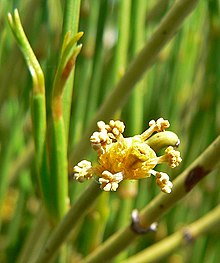
Ephedra distachya is a shrub in the family Ephedraceae that stands about 25 cm to 50 cm high. The shrub grows in many parts of the world, including southern and central Europe and western and central Asia. Its local names include somlatha. Ephedra distachya lives on grey dunes which are fixed and stable sand dunes that are covered in continuous vegetation.

Ephedrine is a central nervous system (CNS) stimulant that is often used to prevent low blood pressure during anesthesia. It has also been used for asthma, narcolepsy, and obesity but is not the preferred treatment. It is of unclear benefit in nasal congestion. It can be taken by mouth or by injection into a muscle, vein, or just under the skin. Onset with intravenous use is fast, while injection into a muscle can take 20 minutes, and by mouth can take an hour for effect. When given by injection it lasts about an hour and when taken by mouth it can last up to four hours.
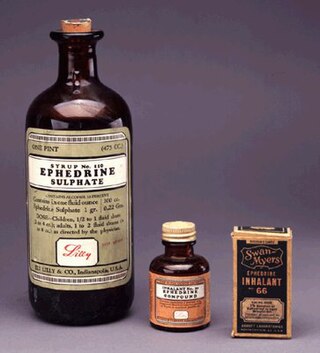
Ephedra is a medicinal preparation from the plant Ephedra sinica. Several additional species belonging to the genus Ephedra have traditionally been used for a variety of medicinal purposes, and are a possible candidate for the soma plant of Indo-Iranian religion. It has been used in traditional Chinese medicine, in which it is referred to as Ma Huang, for more than 2,000 years. Native Americans and Mormon pioneers drank a tea brewed from other Ephedra species, called "Mormon tea" and "Indian tea".

Alnus glutinosa, the common alder, black alder, European alder, European black alder, or just alder, is a species of tree in the family Betulaceae, native to most of Europe, southwest Asia and northern Africa. It thrives in wet locations where its association with the bacterium Frankia alni enables it to grow in poor quality soils. It is a medium-sized, short-lived tree growing to a height of up to 30 metres (98 feet). It has short-stalked rounded leaves and separate male and female flowers in the form of catkins. The small, rounded fruits are cone-like and the seeds are dispersed by wind and water.

Sida cordifolia is a perennial subshrub of the mallow family Malvaceae native to India. It has naturalized throughout the world, and is considered an invasive weed in Africa, Australia, the southern United States, Hawaiian Islands, New Guinea, and French Polynesia. The specific name, cordifolia, refers to the heart-shaped leaf.

Sida rhombifolia, commonly known as arrowleaf sida, is a perennial or sometimes annual plant in the Family Malvaceae, native to the Old World tropics and subtropics. Other common names include rhombus-leaved sida, Paddy's lucerne, jelly leaf, and also somewhat confusingly as Cuban jute, Queensland-hemp, and Indian hemp. Synonyms include Malva rhombifolia. It is used in Ayurvedic medicine, where it is known as kurumthotti.
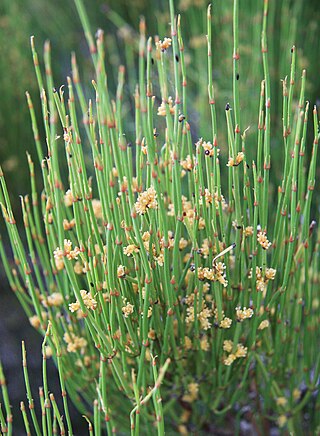
Ephedra is a genus of gymnosperm shrubs. The various species of Ephedra are widespread in many arid regions of the world, ranging across southwestern North America, southern Europe, northern Africa, southwest and central Asia, northern China and western South America. It is the only extant genus in its family, Ephedraceae, and order, Ephedrales, and one of the three living members of the division Gnetophyta alongside Gnetum and Welwitschia.
There has been much speculation as to the botanical identity of soma or haoma. Soma is a plant described in Hindu sacred texts including the Rigveda, while haoma is a plant described in the Avesta, a collection of Zoroastrian writings. Both names are derived from the Proto-Indo-Iranian *Sauma. Proposed candidates include various species of plants and or fungi. Traditional etymology of Indian Soma is Somalata used traditionally by the Srauta Brahmins called Somayajis whereas the Avestan Haoma is an Ephedra, which are totally unconnected species sourced from different areas. European researchers suggest other plants, such as the perennial Peganum harmala, Nelumbo nucifera, Cannabis sativa, and the sugarcane species Tripidium bengalense ; while fungal candidates include the fly-agaric mushroom Amanita muscaria, the psilocybin-containing mushroom Psilocybe cubensis, and the ergot fungus Claviceps purpurea. Other scholarly proposals include mixtures of these candidates with each other and with other substances.

Ephedra aspera is a species of Ephedra known by the common names rough jointfir, boundary ephedra, and pitamoreal. It is native to the southwestern United States from California to Texas and parts of northern Mexico as far south as Zacatecas. It is a resident of varied woodland and scrub plant communities.

Ephedra californica is a species of Ephedra, known by the common names California jointfir, California ephedra, desert tea, Mormon tea, and cañatillo.
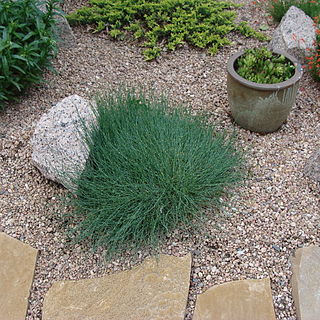
Ephedra funerea is a species of Ephedra, known by the common name Death Valley jointfir, Death Valley ephedra, or Mormon Tea.
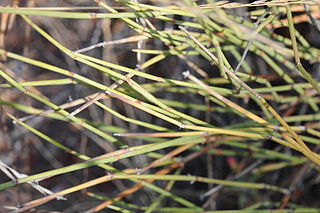
Ephedra trifurca is a species of Ephedra known by the common names longleaf jointfir and Mexican tea.
Ephedra alata is a species of Ephedra. These plants are perennial and xerophytic gymnosperm shrubs.
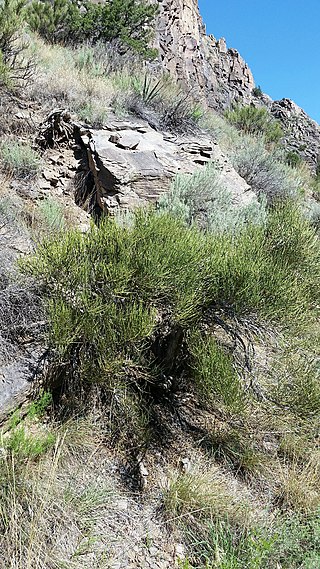
Ephedra cutleri, the Navajo ephedra or Cutler's jointfir, is a species of Ephedra that is native to the Southwestern United States.

Ephedra altissima is a species of Ephedra that is native to the western Sahara, and also to the Canary Islands.

Ephedra nevadensis, commonly known as Nevada ephedra, gray ephedra, Mormon tea and Nevada jointfir, is a species of gymnosperm native to dry areas of western North America.

Lycium pallidum is a species of flowering plant in the nightshade family known by the common names pale wolfberry and pale desert-thorn. It is native to northern Mexico and the southwestern United States. In Mexico it can be found in Sonora, Chihuahua, Zacatecas, and San Luis Potosi. In the United States it occurs from California to Texas and as far north as Utah and Colorado.
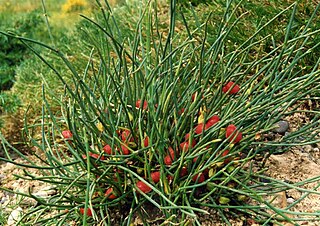
Ephedra monosperma, also called Ephedra minima or dan zi ma huang, is small shrub in the family of Ephedraceae.
Ephedra pedunculata, common name vine Mormon tea or Comida de Vívora, is a plant species native to southern Texas and to Mexico as far south as Zacatecas. It grows in sandy or rocky slopes and outcrops.

